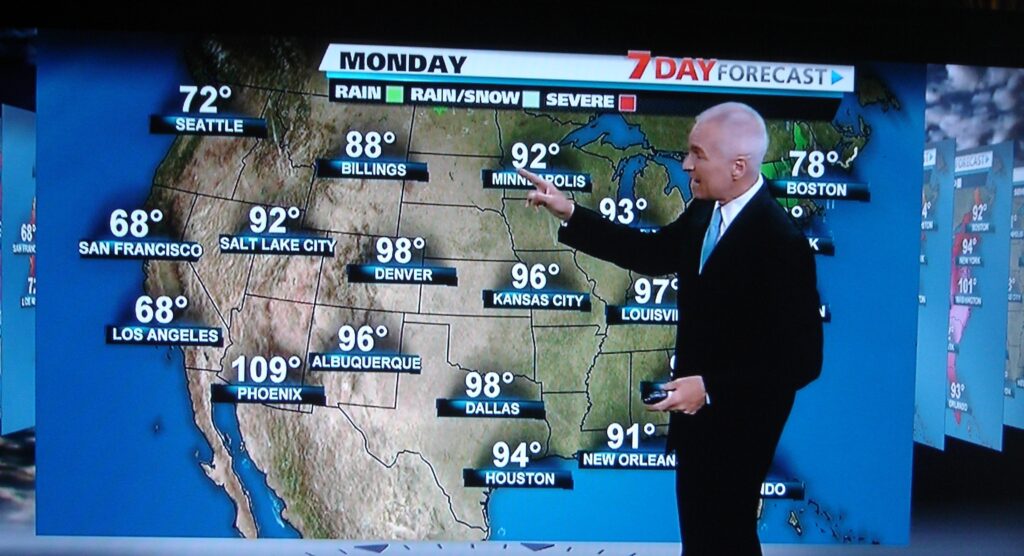
As a reporter, there will likely be many times when you will have to go outside and cover a weather story. While this is normally the weather forecaster’s job, that person usually has to stay inside with the green screen and radar equipment. In a larger station, there might be multiple on-air personalities in the weather department, some of whom can stand outside while others remain in the studio. But in smaller stations (where you will likely end up after graduation, as discussed in last week’s post), this job often falls to someone in the news department. This is especially true on a slow news day, but depending on the severity of the weather, it may happen at other times as well.
What to Do When You’re Standing Outside Stating the Obvious
Frequently, this is not the most interesting type of story to cover. You may be pointing at the sky and explaining that it is raining, in case your viewers haven’t noticed. Worse, you’re unlikely to have a direct quote from Mother Nature about today’s activities.
The best thing you can do is try to plan ahead of time. Big weather events can usually be predicted, so you should get your assignment for this kind of coverage at the daily news meeting. Plan a list of weather-related things you can talk about that don’t include the obvious. Coordinate with the weather forecaster to make sure you’re not both talking about the same things, as viewers get bored easily. Most meteorologists mention standard reminders like bringing pets and plants inside when it’s cold and taking shelter in a severe thunderstorm or tornado threat. You should try to come up with other talking points.
Here are some general suggestions with examples:
• Effects the weather is having on the local economy (for example, no one is venturing out in the snow to shop; the drought is affecting local farmers)
• Problems for specific segments of the audience (community cooling centers or low-cost fan programs for people who are homeless or can’t afford to air-condition their homes; how people who have to work outdoors deal with extreme weather conditions)
• Tips about things related to weather that viewers may not have considered or had time to deal with (how to winterize your car; what to do if your basement floods; inexpensive temporary fixes for a leaky roof)
• Look for information that is relevant to viewers, which is “news you can use.” Compelling characters are at the core of every successful news stories, including the snow pile driver, the mother with the flooded basement, and the volunteer firefighter.
As with other types of news stories, you should always try to include a quote—on camera, if at all possible, but using audio from a phone conversation can work if an in-person interview isn’t going to happen. You may not be able to interview Mother Nature, but you can get a quote from the local police about road conditions, the increase in accidents they usually see with this type of weather, etc. Or you can interview a local business owner about how the weather has created challenges or opportunities for her store.
“As You Can See Here…”
Avoid this phrase. Viewers already know what they can see on the screen. If you think a visual might be confusing, just explain it with specifics. For example, “Those green bars your see in the middle of the water are actually the rails of a childrens’ slide in the park. The creek is so swollen from the last three days of rain that water has covered almost the entire slide.”
Don’t Be a Hero
You may have seen exciting viral videos of reporters clinging to traffic signs in hurricanes, shouting to be heard over the pounding of a heavy rainfall, etc. While these videos sometimes get shared a lot on social media, and might look good on your audition tape, you should still proceed with caution. Many TV stations have policies in place to prevent reporters from doing anything extremely dangerous in the name of getting a great shot. After all, no one wants to read the story about how their colleague was killed chasing a tornado.
If it isn’t too dangerous to go outside, you should still exercise caution and consider the picture and sound quality you’ll have. Even with a windscreen on your mic, sometimes weather conditions can make audio unintelligible. A news camera is an expensive piece of equipment that should be protected from rain with an umbrella—but remember that if it’s not only raining but windy, water might fly onto the lens. This probably won’t damage the camera, but it can make for a blurry live shot. Viewers at home don’t want to see the photographer’s fingers wiping the lens and doing so with wool gloves will scratch the lens. Also consider using compressed air, but never blow on the lens as eventually saliva will get mixed in, harming the lens.
One solution is the “back door” shot, where the photographer positions the camera inside the station with the back door propped open, and the reporter stands outside under an umbrella. Another alternative is to place the reporter in front of a green screen, which can have an image from the station’s permanent outdoor camera (often used in weather or to show the sunset at the end of early evening broadcasts). Yes, it will be obvious to discerning viewers that the reporter isn’t actually outside, but this is sometimes a better solution than poor picture or sound quality, and the reporter can still point out specifics in the shot.
[su_note]Learn more about the School of Broadcast Journalism at the New York Film Academy by clicking here.[/su_note]